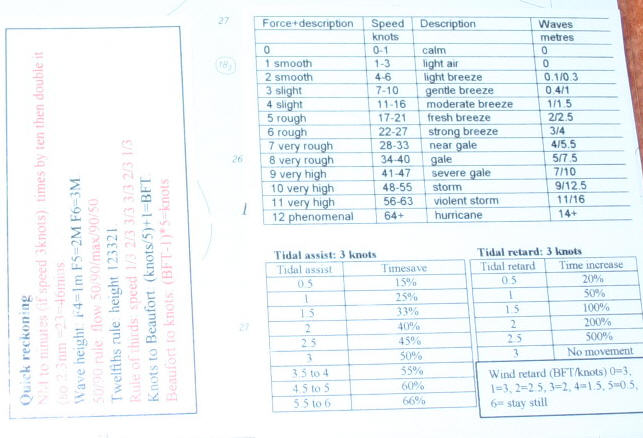| CALCULATING TIME & TIDE By Julian Patrick - 2006
As part of training for my 5-star I felt that I should fairly accurately know, without a lot of involved mathematics, how long it would take to paddle a certain distance in a variety of tidal conditions. Example: Look at map and deduce headland A to headland B is 4.2NM (nautical miles for those who work in km) and to the best of our knowledge we have the tide with us at 1.5 knots. How long to get there? Can you work it out? Can you work it out quickly without paper and pen, sitting in a kayak knowing that the overfalls at the headland start soon and if you look down for a second longer you'll be seasick? Or the assessor is asking you that very question and your "group" are all looking at you with those "he's gonna fail" eyes...? With the wrong assessor (:-)) that's what you'll get. I devised my own little system and it works for me. Firstly work with charts. Everything on a chart is in Nautical Miles and Knots. One knot is near enough 1 nautical mile an hour for the purpose of simplicity. As a rough guide a weekend sea paddler will travel at 3 NM per hour (most paddlers are not far off of this). I have tested this on the GPS and is pretty spot on. So, ignoring wind and tide assume paddling speed is 3NM/hour. To convert NM to "minutes to get there" the formula is: times by ten and double it. So, in the case above 4.2X10 = 42. Double it = 84 minutes. Quick and easy. A few more examples... 2.3NM = 2.3X10=23X2 = 46 minutes. But of course you have tidal assist (or tidal retard). I made a little crib sheet for this then memorised it and it goes like this. Tidal assist 0.5 knots = 15% less time (these figures are rounded for ease of memory). So if we know that we are going to take 60 minutes to complete a trip but we have 1 knot of assist then the time saving is 25% and the new time is therefore 45 minutes. If the time is going to be 20 minutes and the tidal flow is 0.5 knots then the new times is 20 mins less 15% = 17 mins. If you are not used to working in percentages get practising... you can do it. There are ways of learning to do this quickly... Sounds a bit complicated to start with but all you need to know is... NM: times by ten and double it With that scribbled on your boat (or in your head) you can work out times quickly and easily. If you want to get real clever ... what if the tide is against you? Then the percentages are... 0.5 20% (not so friendly are they?) The new crib becomes... NM: times by ten and double it My crib below...
Sorry - if you work in km you'll have to do your own little equations :-) Ps. If my formula is wrong let me know... took me ages to work it out but who knows! PPS... What about wind... Tend to just go with an educated guess at the moment but do have a scale on pictured crib card... yet to test it thoroughly tho... ~~~ Word docs with the Crib Sheet content can be downloaded by clicking here and Tidal Constants for Anglesey here. Julian has also devised a cunning method for organising charts/maps etc on a sea kayak - click here for details of his "Navigation Board". Julian Patrick - 2006
|
~ ~ ~
